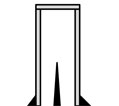TAML level 1
Basic multilateral junction consists of an openhole main bore with one or multiple drainage legs (or laterals) exiting from it (Fig 1). The junction in this design is left with no mechanical support or hydraulic isolation. The integrity of the junction is dependent on natural borehole stability, but it is possible to land a slotted liner in the lateral or the main bore to help keep the hole open during production. The production from a Level 1 system must be commingled, and zonal isolation or selective control of production is not possible. Re-entry into either the main bore or the lateral may be difficult or impossible should well intervention be required in the future.

TAML level 2
Level 2 junction consists of cased and cemented main bore with uncased lateral (Fig 2). The cased main bore minimizes the chances of borehole collapse and provides a means of hydraulic isolation between zones. As with Level 1, there is no actual mechanical support of the lateral junction, but it is possible to run a slotted liner into the lateral to maintain borehole stability.

TAML level 3
The Level 3 junction uses a cased and cemented main bore with an openhole lateral (Fig 3). This system offers mechanical support of the lateral junction, and provides access into both laterals.

TAML level 4
Level 4 junction offers both a cased and a cemented main bore and lateral (Fig 4). This gives the lateral mechanical support, but the cement itself does not offer pressure integrity at the junction. There is a potential for failure if the junction is subjected to a pressure drawdown. Zonal isolation and selectivity is possible by installing packers above and below the junction in the main bore.

TAML level 5
The Level 5 multilateral junction has both cased main bore and lateral, which offers great level of mechanical integrity (Fig 5). Pressure integrity has been achieved by using completion to isolate the junction. This junction type offers full access to both the main bore and the lateral. The zones can be produced independent of one another, or the completion can be designed to allow them to be commingled.

TAML level 6
In the Level 6 multilateral system, both mechanical and pressure integrity are achieved by using the casing to seal the junction (Fig 6). Cementing the junction, as was done in the Level 4 system, is not acceptable. The Level 6 system uses a premanufactured junction. In one type of system, the junction is reformed downhole. TAML6 junction as of today are not considered to be viable because of significant loss of ID and complexity of installation. Contemporary TAML5 systems offer higher pressure ratings and IDs which almost made TAML 6 junctions expired technology.



